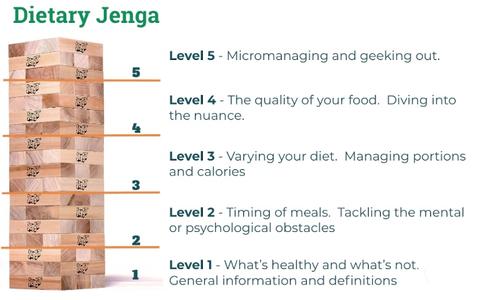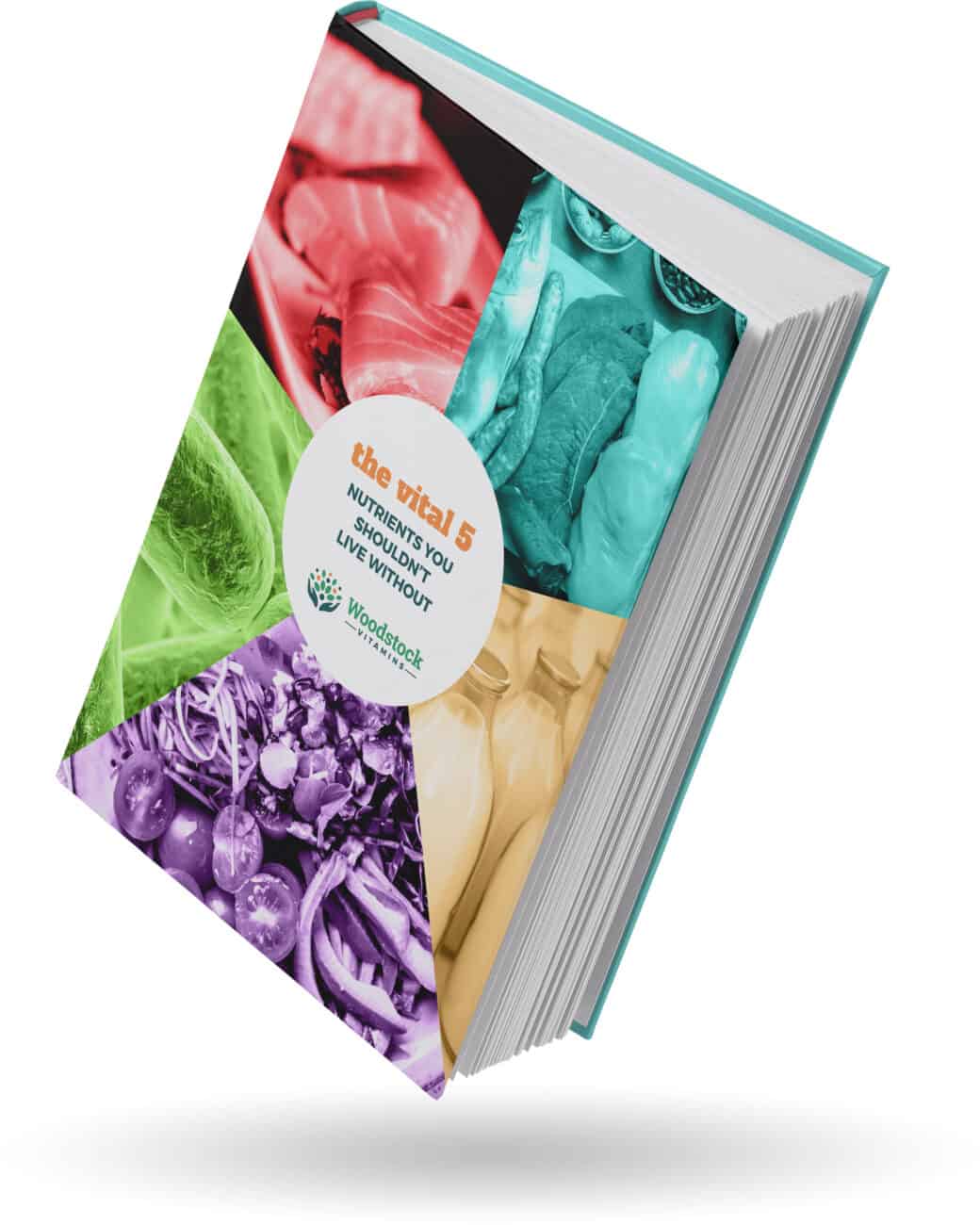The biggest problem most of us have with nutrition is the overwhelming nature of nutrition information. I believe that diet is a bigger source of confusion than any other health and wellness topic. There are a few reasons why people are so confused.
First, none of us has any professional training in this. I have a 6 year degree in Pharmacy, and the last formal nutrition training I have was in Home Economics class in 1994. They taught me the Food Pyramid, where fats were to be eaten sparingly, but corn and bread should be stuffed up your nose for temporary storage as your mouth should be full from ingesting simple carbohydrates constantly.
Where do we get nutritional advice from? Not experts. Instead, we look to “influencers,” which is code word for half-naked people who are #blessed talking about the latest craze and their superfood power shake. Other real-life influencers are our friends and family, or even people we overhear talking about food-related topics. They’re just playing diet-telephone, repeating and diluting the “gist” of the facts down into our common understanding.
It’s tough for us to sort through all the information. Especially when the media is jamming click-bait titles down our throats that often miss the point of the study they’re reporting on. Like we said in our Guide to Dietary Fats – eggs aren’t bad for you, no matter what the newest data point says.
We’re suffering from analysis-paralysis, so we just keep doing what we’re doing. What most of us are doing isn’t good. We rarely eat. Over 60% of all calories taken in here in the US are hyper-processed foods. Think about that for a minute.
Nutrition isn’t that complicated though. Like Meditation and Mindfulness, it’s simple, but not easy. The hardest part of doing nutrition right is changing our behaviors.
Last night I introduced a cool little framework for cutting through the BS. I called it “Dietary Jenga.” Yeah, my analogies are getting a bit crazy…
Dietary Jenga is a five-step system that picks apart the themes of nutrition – the layers that add complexity to our diets and organized them into an easy to follow, step-wise process.
Introducing Dietary Jenga
I’m more prone to use triangles than any other shape, as the Wellness Pyramid has been so good to me. But the one thing I noticed is how people often are hyper-focused on really elaborate nutritional ideas yet neglect dietary basics. I says to myself, “Self, it’s like they’re playing Jenga. They’re pulling their support from the bottom and just piling up on top.” It’s not stable. It will fall.
And it does. Fall into a pile of despair, confusion, and Hostess Ding Dongs.
Instead, we should be building our Jenga tower one row at a time, focusing on filling each section completely with all the necessary bits of information to truly support the structure.
Here’s the money shot:

Let’s talk about the 5 steps of Dietary Jenga and why they’re so important.
Dietary Jenga Level 1 – What’s What
In Level 1, we should just be focused on what’s healthy, what’s not, and basic definitions so we have a real understanding of the terms that get kicked around. What’s the difference between superfoods, whole foods, and food? Nothing!
We have to learn the basics. We can’t take our black belt test if we don’t know the white belt forms or how to do a roundhouse.
These lessons were discussed in length during our Eat to Fuel Your Fire blog that’s a must-read for all nutrition info junkies.
Essentially, we must define what makes a food healthy, what makes a meal healthy, and what makes a day healthy.
We don’t have to complicate it! We always like to do that. Organic, GMO, grass-fed – the list is long and the way is confusing. What really matters is the simplest, universal definitions.
Healthy Food: Rich in 1 of the 3 nutrient dense macronutrients, proteins, healthy fats, and complex carbohydrates.
Healthy Meal: A balance of all 3 macronutrients. Typically 50% complex carbs, 35% protein and 15% healthy fat and some simple carbs are allowed in small amounts
Healthy Day: Eating small frequent meals with snacks every few hours. This maintains energy levels, metabolism, blood sugar, and helps you keep a clear head and a mind as sharp as a tack.
A meal is a large snack and a snack is a small meal. All snacks should be proteins, healthy fats, and complex carbs, too.
Here’s a list of some snack ideas, to show you how easy it is:
- Nuts + Fruit (add a square of dark chocolate!)
- Pepper + Guacamole
- Greek yogurt + berries
- Apple + nut butter
- Celery + peanut butter (A classic!)
- Cottage cheese + flax + berries
- Kale chips + nuts
- Hummus + veggies
- Mozzarella stick + fruit or veggie (cherry tomatoes!)
- Black beans + veggies
Substitute any fruit/veggie and nut butter/cheese!
A note about cost. Healthy, quality food doesn’t always have to be a 401K-draining trip to Whole Foods. Here’s a live feed from a customer interacting with that grocery chain as we speak:

I teach people about the 2 costs of eating healthy: Cost of Food + Cost of Healthcare. The two must be considered together. So while it’s WAY cheaper to eat at McDonald’s today, it will be MUCH more expensive for diabetes medicines, especially here in America.
Most healthy, real foods are very affordable. Don’t overspend for silly claims or labels that are more marketing than they are impactful on your health. There’s a million articles about how to eat healthy on a budget.
Dietary Jenga Level 2 – Observing Our Bad Habits
Level 2 is all about time. It’s digging in and figuring out our psychological connection to food, and how time and our lifestyle create the bad habits we must chan
We’ve addressed in level 1 a bit of what we mean by “timing.” How often we eat is as important as what we eat.
Using our campfire analogy, a healthy, “Healthy Day”, or a well-timed meal plan looks like this:

There is no greater stumbling block to proper nutrition than our psychological connection to food. We know we should be eating more frequently than we do. Why don’t we?
“We don’t have any d*mn time Neal!” says a chorus of people too stressed out to chew.
I have identified many times how if I get stressed, I reach for comfort foods. If I don’t plan my day, I’ll make rash food choices under duress.
Planning your day’s meals and snacks is as important as planning your workout, your workday, or that awkward conversation with your weirdo neighbor.
Here’s a protip: Don’t go to bed at night without planning your meals and snacks for the next day.
By doing so, you can address the biggest obstacle for most of us in nutrition success: our busy lifestyle.
Level 3 – Going Wide. Dialing It In.
At the third level, we focus on really honing our diet into a beautiful thing. This is a goal-oriented stage, where we finally pay attention to the numbers, managing portions, calories, and macronutrient goals. We must vary our diet to get exposure to all the micronutrients. We do so, so we can Throw Away Our Multivitamins.
It is no exaggeration to say that Level 1 and Level 2 of Dietary Jenga are the most important. These are the foundational pieces and habits that will dictate your success. A habit takes about 21 days to build, so I normally tell people their first 3 weeks are just doing those basics.
I will say, “Don’t even think about any other complex food issues!” Just like that too, with quotes.
After a few weeks of eating real foods, balanced together, frequently throughout the day as is best for us modern humans, we can THEN start to dial in our diets.
It’s here where we can start to really branch out and try to vary our diets a bit. Many people will be resistant because they feel overwhelmed with all the choices. The truth is, this part is much easier than we think.
There are just a finite number of foods. It’s not like there are 1000s of different foods. There’s really only a couple hundred or so. Our individual diets are much less varied. I think I eat pretty healthy and there’s probably like 30 things I eat regularly.
I’m not saying to travel to foreign countries to get weirdo things that no one has heard of before. What I’m saying is that if you are supposed to eat 4 servings of fruit a day and there are 7 days a week, you have 28 different slots to fill, and you could fill them with 10 different things and be a very happy camper.
You can really branch out here. Dig into the more rare foods and start adding herbs and spices. So, sure, now you can add in some goji berries or cinnamon. You can start to experiment and expose your body to new, healthy real foods.
You can also start to ensure you are hitting your marks. While I don’t really think most of us should be micromanaging the numbers, I do think most of us should have a general awareness of what our macronutrient and calorie goals are for the day, and build a healthy diet that can guarantee that, on average, we accomplish those goals.
Here are some numbers you should pay attention to:
Dietary Protein Goals
- The official range is 0.8-1.2 grams of protein per kg of body weight each day.
- Calculate your weight in kg by dividing your weight in lbs by 2.2.
- Example:
- My weight is 220 (ish). That means I’m 100 kg (220 divided by 2.2).
- My protein goals every day are between 80 and 120 grams. (0.8 and 1.2 multiplied by 100 kg)
- I tell people to shoot for 1 gram per kg of body weight.
Fluid Goals
Water is considered by some to be the fourth macronutrient. We don’t drink nearly enough, and in our article Natural (And Cheap) Treatment For Cramps, we talk about the importance of water.
A good rule of thumb for hydration is to drink half your body weight in ounces of water daily, with a minimum of 64 ounces.
Caffeine and alcohol don’t count, but in fact, take away. Drink an additional 8 oz to make up for those effects.
Don’t forget what you sweat off, either. You can lose up to 4 liters per hour when you work out!
The official formula is: half your body weight in ounces + 8 oz for each caffeinated/alcoholic beverage + losses from exercise.
As an aside, I tell people water or bust. Don’t get calories from your drinks, as it decreases the amount of M&M’s you can eat daily.
Calorie Goals
Calories are age, height, gender, weight, and activity level dependent. It’s best to use an official calculator. The one at Calculator.net is great, because it even gives you an estimate of how to lose weight over time safely.
Dietary Fiber Goals
The official range is 21-38 grams of dietary fiber a day, and that varies by gender and age. I use a rough estimate of 30 grams. Why? Everyone has a problem pooping, and fiber is one of the 4 Pillars Of Gut Health. Get more dietary fiber!
Saturated Fat Limits
The last number to know is how much saturated fat you should eat. It should be only about 10% of your total calories at most. I would keep it as close to 0 as possible, as saturated fat can contribute to hardening of the arteries. So, do your calorie calculations and limit your saturated fat down.
Again, let’s not go nuts, but we should have an awareness of where we need to be.
A big caveat: most of our estimates are way off. We don’t know how many grams of protein or calories the piece of salmon in front of you has, or if it is even exactly 4 ounces. What we do know, is that many of them are XX calories and have XX grams.
When you are measuring calories and grams, make sure you adjust for reality. We often under-estimate calories and overestimate the healthy bits of foods or our exercise impact.
I shared a few links last night to databases where you can put in your food and it will output nutritional information. The USDA site and Self.com are two of our favorites. When looking generally, it’s ok to use the Google machine. “What foods are rich in dietary fiber” will get you a clean list as every health and wellness brand on the planet is writing those types of articles.
Level 4 – Food Quality
Level 4 of Dietary Jenga is the stage where you can start to focus on food quality and trying to really optimize your food sources.
I could write an entire piece on the quality of food. There’s a ton of back and forth about this. What really matters? What doesn’t?
Some people feel that we stress too much about the quality of food and most of the info out there is really just marketing to sell higher cost stuff to rich people. I’m sure there’s a bit of that out there, but we also know the food supply chain is as American as ever. Meaning it’s optimized for profit, not our wellbeing.
I’d say that for most of our purposes, we MUST be concerned with the quality of our food, especially if we are doing Levels 1-3 right.
Just like I identified in the 3 Types Of Dietary Supplements there are varying qualities of food out there. And just like supplements, it’s difficult for a consumer to tell what’s real and what isn’t.
Again, try to get really good at checking off the more “high-level” boxes around food quality. There’s plenty of time to geek out in Level 5.
In general, try for seasonal food grown locally. You’re more likely to have more nutrient dense, truly ripened food that probably has been farmed using better methods than the mass-mega-super farms that are shipping stuff weeks in advance of ripening and gassing them to make them look ready to eat.
You should be concerned with chemical exposure, so think about added pesticides, herbicides, fungicides, or antibiotic and hormone use in animals.
Look for free range and grass-fed or pasture-raised animals. Stay away from farmed fish.
Finally, consider the ethics of the food company.
Your chicken shouldn’t be an unlicensed MMA fighter, shadow boxing in the background of the farm. Your cow shouldn’t look like this monster:

There’s a big jump in quality from the chicken you’ll get at a gas station to even the worst grocery stores. There’s a smaller jump in quality from the grocery store to the local butcher. That last jump, though, is where we want to go – essentially 50 years in the past, before the mass-production spectacle that is modern farming.
Level 5 – Geeking Out
There are some people so into food that they want to know the optimal amount of protein to eat per meal to maximize the muscle build vs burn.
Some people read all the articles. They check out every new study that even remotely mentions diet. There’s high-level concepts, loose correlations, and in general cutting edge thought processes around nutrition. This stuff doesn’t belong in the beginners head at all.
There’s a lot of minutiae that you could dive into around food. If you’re into it, do it. But save it for the last stage of the journey, after you’ve thoroughly mastered Levels 1-4 of the silliest analogy in the world: Dietary Jenga.
Dietary Jenga – Where Blocks And Broccoli Merge
The thing about healthy nutrition is that everyone “knows” what to do. Despite everyone knowing, we tend to shy away from the clear cut path to long term health. The one we KNOW will produce better outcomes and longevity. A recently released study highlights the impact of poor nutrition on health, as they found thousands of cancer diagnoses were tied to poor diet.
We shy away from the real answer and look for sexier, easier solutions. Partly because nutrition kind of looks like this to most of us:

Our silly-not-so-silly framework of Dietary Jenga helps pull out the complexity of nutrition information and set up very attainable goals for achieving nutritional success.
The hardest work is the work around our behaviors. At some point, we have to put our foot down and stop the “go-go-go” mentality we’ve built. We need to slow down, or at least adopt new behaviors that help us do what’s most important, best caring for our own health.
I’ll leave you with a “Neal quote” from last night:
Good nutrition is simple. Most of us have a sense for best practices. Good nutrition, though, is not easy. It is often overcomplicated. Most importantly, it’s our behavior, not our food that must change first.
I hope Dietary Jenga helps a couple of people make better sense of the madness around nutrition.
Just trying to keep it real…

Neal Smoller, PharmD
Owner, Pharmacist, Big Mouth



